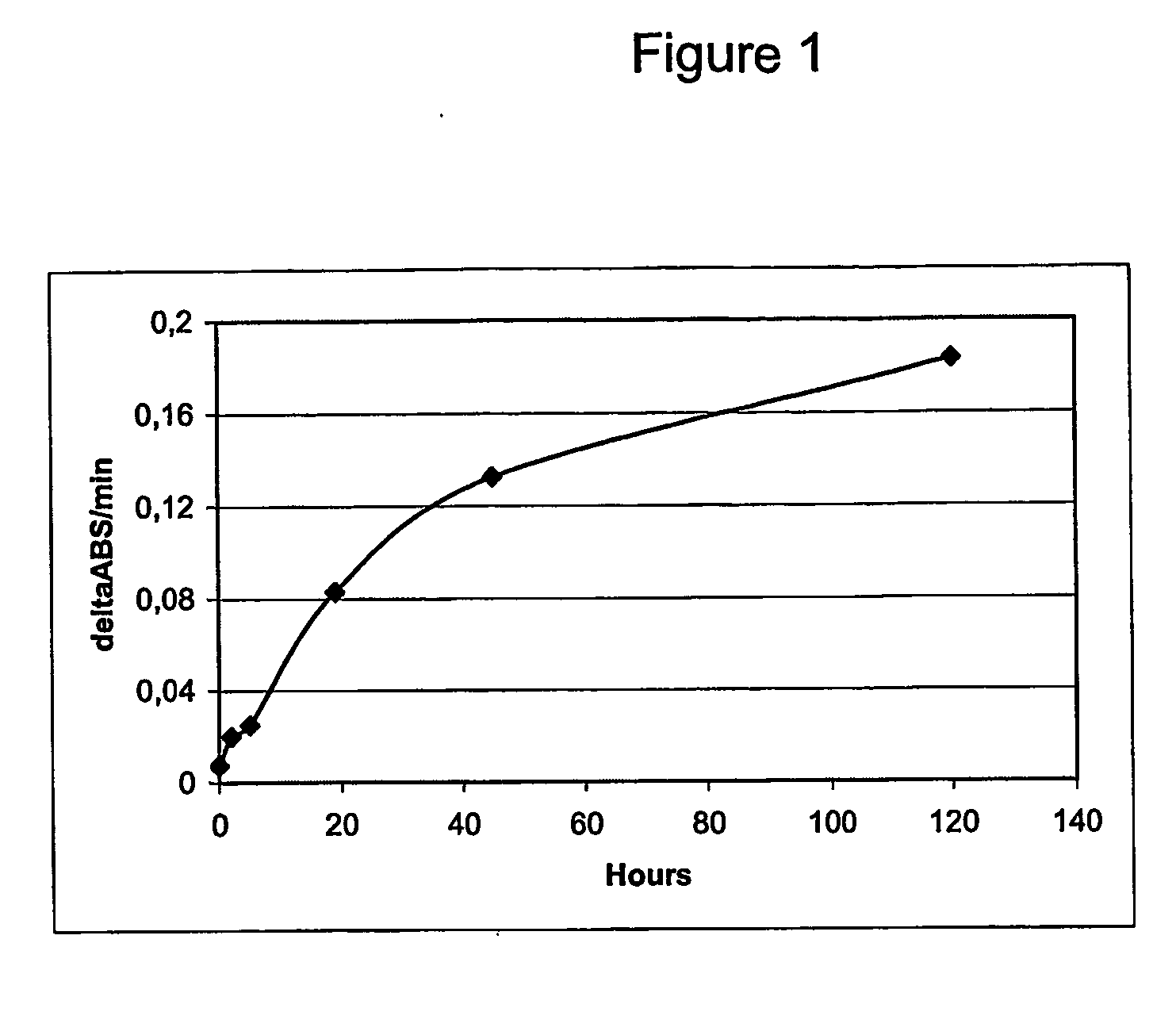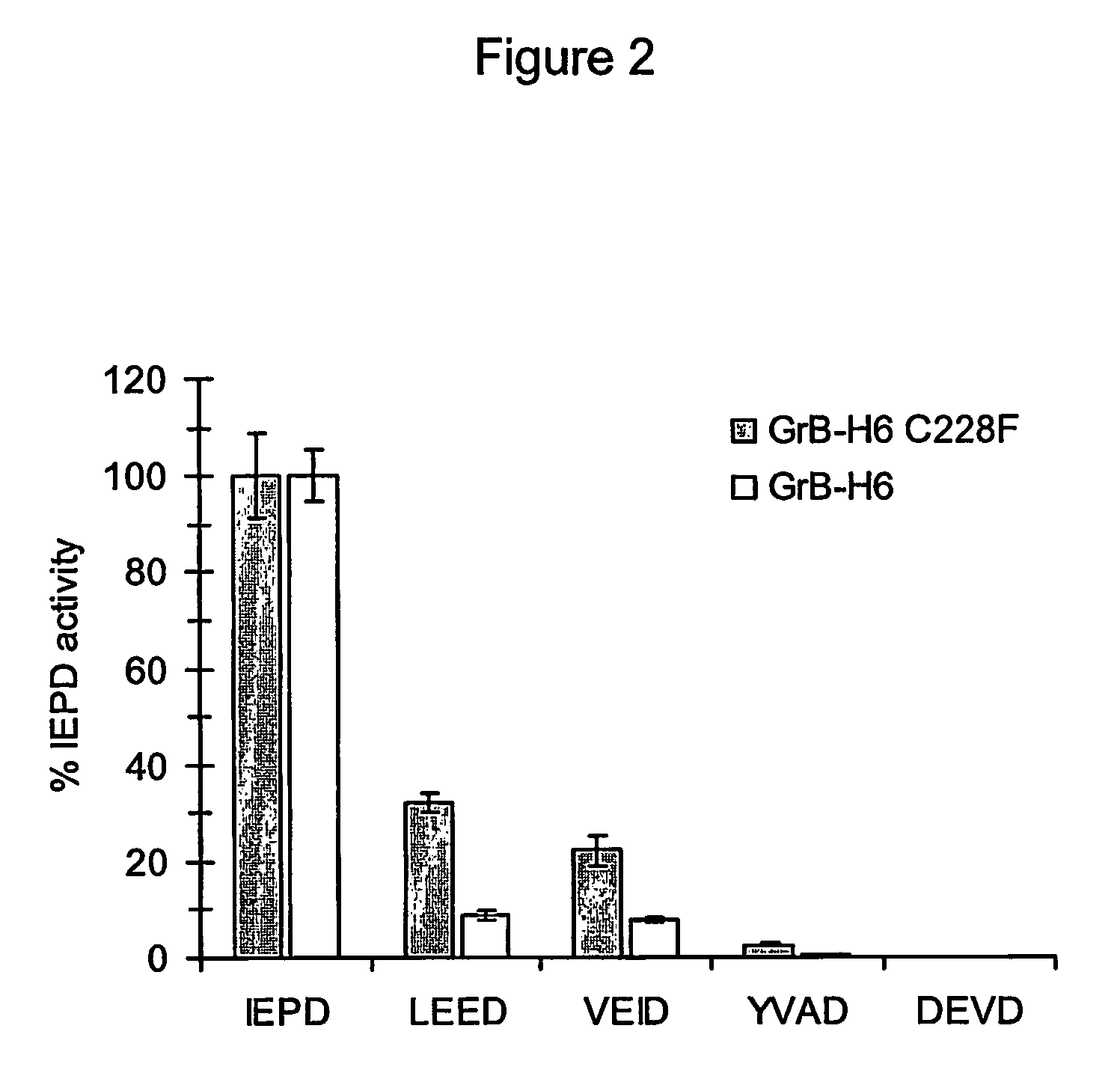Cleavage of fusion proteins using granzyme b protease
a granzyme b protease and fusion protein technology, applied in the field of granzyme b protease fusion protein cleavage, can solve the problems of limited enzymatic cleavage of fusion proteins, severe affecting the bioactivity of polypeptides, and problems such as antigenicity problems
- Summary
- Abstract
- Description
- Claims
- Application Information
AI Technical Summary
Benefits of technology
Problems solved by technology
Method used
Image
Examples
example 1
[0308] Design and Construction of Human Granzyme B Expression Vectors
[0309] In order to prepare inactive pro-Granzyme B constructs, a sequence encoding activated human Granzyme B (E.C. 3.4.21.79), i.e. from Ile21 (Ile16 in chymotrypsinogen numbering) to Tyr246, was cloned into a pT7 cloning vector containing a hexa-His tag (H6) C-terminally (pT7 C-term H6), resulting in the expression vector pT7-IEGR-GrB—H6. The sequence, MGSIEGR, containing the blood clotting factor Xa (FXa) recognition sequence IEGR was thereby placed just N— terminally to Ile21 in Granzyme B providing a FXa cleavage site between Arg (R) and Ile21. The resulting fusion protein pro-Granzyme B containing the FXa recognition sequence and the C-terminal hexa-His tag is in the following referred to as pro-IEGR-GrB—H6 and is shown in SEQ ID NO:1.
[0310] In order to form self-activating pro-Granzyme B proteins, the expression vectors pT7-IEPD-GrB—H6 and pT7-IEAD-GrB—H6 were constructed, wherein the FXa recognition seque...
example 2
[0320] Expression and Refolding of Self-Activating Human Granzyme B
[0321] FXa Activateable Recombinant Pro-IEGR-GrB—H6
[0322] The FXa activateable recombinant pro-Granzyme B fusion protein pro-IEGR-GrB—H6 (SEQ ID NO:1) was produced by growing and expressing the expression vector pT7-IEGR-GrB—H6 prepared in Example 1 in E. coli BL21 cells in a medium scale (3×1 litre) as described by Studier F W et al. (1990). Exponentially growing cultures at 37° C. were at OD600=0.8 infected with bacteriophage λCE6 at a multiplicity of approximately 5. Cultures were grown at 37° C. and 50 min after infection 0.1 g / L rifampicin (dissolved as 0.1 g / mL in methanol) was added. After another three hours at 37° C. the cells were harvested by centrifugation. The cells were lysed by osmotic shock and sonification and total cellular protein was extracted into phenol (adjusted to pH 8 with Trisma base). The protein was precipitated from the phenol phase by addition of 2.5 volumes of ethanol and centrifugati...
example 3
[0337] Activation of pro-IEGR-GrB—H6 Fusion Protein using Purified Bovine Factor Xa and Self-Activation of pro-IEPD-GrB—H6 and pro-IEAD-GrB—H6
[0338] Activation of pro-IEGR-GrB—H6 by Factor Xa
[0339] A sample of monomeric inactive pro-IEGR-GrB—H6 produced as described in Example 2, was taken directly from the eluate from the SP Sepharose ion exchange. One mg of pro-IEGR-GrB—H6 (in app. 10 ml) was activated by the addition of 50 μg FXa (50 μl of 1 mg / ml) and incubated at room temperature for several days. The degree of cleavage / activation of pro-IEGR-GrB—H6 by FXa, resulting in GrB—H6, was estimated by SDS PAGE.
[0340] In addition, the Granzyme B activity during an incubation of pro-IEGR-GrB—H6 with FXa was followed for several days using the following colorimetric assay: 500 μl buffer (100 mM NaCl, 50 mM Tris-HCl pH 8.0), 4 μl 100 mM Ac—IEPD-pNA, and 5 μl incubation mixture. The incubation mixture was prepared by mixing 100 μl pro-IEGR-GrB—H6 (approximately 10 μg) with 1 μl FXa (1 m...
PUM
| Property | Measurement | Unit |
|---|---|---|
| temperatures | aaaaa | aaaaa |
| temperatures | aaaaa | aaaaa |
| temperatures | aaaaa | aaaaa |
Abstract
Description
Claims
Application Information
 Login to View More
Login to View More - R&D
- Intellectual Property
- Life Sciences
- Materials
- Tech Scout
- Unparalleled Data Quality
- Higher Quality Content
- 60% Fewer Hallucinations
Browse by: Latest US Patents, China's latest patents, Technical Efficacy Thesaurus, Application Domain, Technology Topic, Popular Technical Reports.
© 2025 PatSnap. All rights reserved.Legal|Privacy policy|Modern Slavery Act Transparency Statement|Sitemap|About US| Contact US: help@patsnap.com



